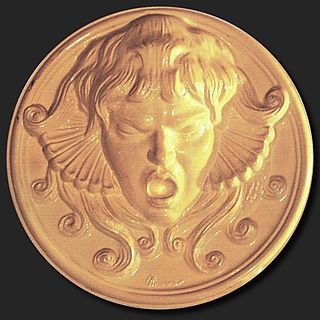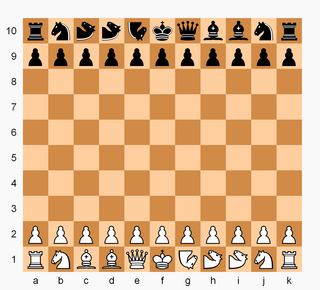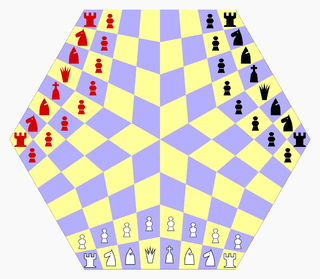Circe chess is a chess variant in which captured pieces are reborn on their starting positions as soon as they are captured. The game was invented by French composer Pierre Monréal in 1967 and the rules of Circe chess were first detailed by Monréal and Jean-Pierre Boyer in an article in Problème, 1968.
A fairy chess piece, variant chess piece, unorthodox chess piece, or heterodox chess piece is a chess piece not used in conventional chess but incorporated into certain chess variants and some chess problems. Compared to conventional pieces, fairy pieces vary mostly in the way they move, but they may also follow special rules for capturing, promotions, etc. Because of the distributed and uncoordinated nature of unorthodox chess development, the same piece can have different names, and different pieces can have the same name in various contexts as it can be noted in the list of fairy chess pieces.

Grid chess is a chess variant invented by Walter Stead in 1953. It is played on a grid board. This is a normal 64-square chessboard with a grid of lines further dividing it into larger squares. A single additional rule governs Grid chess: for a move to be legal, the piece moved must cross at least one grid line.
Fairy chess is the area of chess composition in which there are some changes to the rules of chess. The term was introduced by Henry Tate in 1914. Thomas R. Dawson (1889–1951), the "father of fairy chess", invented many fairy pieces and new conditions. He was also problem editor of Fairy Chess Review (1930–1951).
Madrasi chess is a chess variant invented in 1979 by Abdul Jabbar Karwatkar. The game uses the conventional rules of chess with the addition that when a piece is attacked by a piece of the same type but opposite colour it is paralysed and becomes unable to move, capture or give check.
Checkless chess, also known as prohibition chess, is a chess variant where neither player may give check unless it is checkmate. All other rules are as in regular chess. The origin of the game is unknown, dating from the mid-19th century. The variant is a popular problem theme, usually requiring a fairy mate.

Thomas Rayner Dawson was an English chess problemist and is acknowledged as "the father of Fairy Chess". He invented many fairy pieces and new conditions. He introduced the popular fairy pieces grasshopper, nightrider, and many other fairy chess ideas.
Grasshopper chess is a chess variant, in which the pawns are allowed to promote to a fairy piece, the grasshopper. The grasshopper must hop over other pieces in order to move or capture.
Monochromatic chess is a chess variant with unknown origin. The initial board position and all rules are the same as in regular chess, except that pieces that begin on a black square must always stay on a black square and pieces that begin on a white square must always stay on a white square. This would mean that knights can never move, but The Classified Encyclopedia of Chess Variants says that knights make a double jump. It has been suggested that a knight be replaced with a (3,1)-leaper (camel).
The Berolina pawn is a popular fairy chess piece based on the pawn. It may move one vacant square diagonally forward, it may move two vacant squares diagonally forward on its first move, and it may capture one square vertically forward. It was invented by Edmund Nebermann in 1926, who named it after the city of Berlin in which he worked. The Berolina pawn is featured in Berolina chess and has found frequent use in chess problems.

2000 A.D. is a chess variant created by V. R. Parton which employs fairy chess pieces on a 10×10 board. Parton published the variant in his 1972 monograph My Game for 2000 A.D. and After.

Wildebeest chess is a chess variant created by R. Wayne Schmittberger in 1987. The Wildebeest board is 11×10 squares. Besides the standard chess pieces, each side has two camels and one "wildebeest" - a piece which may move as either a camel or a knight.

Chesquerque is a chess variant invented by George R. Dekle Sr. in 1986. The game is played on a board composed of four Alquerque boards combined into a square. Like Alquerque, pieces are positioned on points of intersection and make their moves along marked lines ; as such, the board comprises a 9×9 grid with 81 positions (points) that pieces can move to.

Three-man chess is a chess variant for three players invented by George R. Dekle Sr. in 1984. The game is played on a hexagonal board comprising 96 quadrilateral cells. Each player controls a standard army of chess pieces.
The dabbaba, also known as the dabaaba or dabbabah, is a fairy chess piece that jumps two squares orthogonally, leaping over any intermediate piece. In algebraic notation, it is given the symbol D.

Beirut chess is a chess variant invented by Jim Winslow in 1992. The game is played using the standard chess pieces and board, with each side having secretly equipped one of their men with a "bomb"—which can be "detonated" at any time, wiping out all men on surrounding squares along with the bomb carrier.

Falcon–hunter chess is a chess variant invented by Karl Schultz in 1943, employing the two fairy chess pieces falcon and hunter. The game takes several forms, including variations hunter chess and decimal falcon–hunter chess added in the 1950s.

Hostage chess is a chess variant invented by John A. Leslie in 1997. Captured pieces are not eliminated from the game but can reenter active play through drops, similar to shogi. Unlike shogi, the piece a player may drop is one of their own pieces previously captured by the opponent. In exchange, the player returns a previously captured enemy piece which the opponent may drop on a future turn. This is the characteristic feature of the game.
Grant Acedrex is a medieval chess variant dating back to the time of King Alfonso X of Castile. It appears in the Libro de los Juegos of 1283.

A chess variant is a game related to, derived from, or inspired by chess. Such variants can differ from chess in many different ways.










